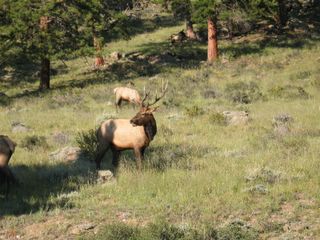Estes Park - September 2006
Sue and I, with her sister and brother-in-law from Oklahoma, enjoyed a nice retreat in Estes Park CO last week. We spent three nights in a neat cabin at our favorite place, Castle Mountain Lodge. We’ve been doing this at least once a year for many years, sometimes all four of us, and other times just the two of us. Fall River flows close by our cabin, low at this time of year, but still refreshing and beautiful. Willows grow along the bank, and we can walk along the river for a considerable distance, seeing only ducks in the stream and the tracks and sign of other wildlife, such as deer and elk, along the edge. We have even observed a black bear foraging around our cabin, on previous trips here.
One of our favorite things to do during these visits is to watch and listen to the elk in Rocky Mountain National Park, only a couple of miles from our cabin. The only distraction to us is the amount of traffic caused by so many other people also there for the same reasons. Cameras and binoculars abound, and the vehicle license plates announce folks from many other states, but especially Nebraska, Kansas, Oklahoma, and Texas, although some are from as far away as both east and west coasts, with an occasional one from Canada.
Sometimes, we use our binoculars to observe the elk herds, and sometimes they are within a few feet of our car. It can be a little dangerous to get too close to elk at this time of year. It is the rutting season, and we see bulls mating with cows often, when they are not too busy keeping their harems together and chasing off other bulls. When two bulls clash antlers, to determine who will control the herd, the sound can be heard from quite a distance.
The elk bugle sound is somewhat surprising, the first time you hear it. In the dark, it is a very eerie sound, especially when it echoes in the valleys, and you can’t be certain what direction it originally came from. When you can watch the bulls bugling, you expect to hear a deep, roaring sound from those massive beasts, but what you hear is a loud, high-pitched squeaking noise. Still, it is impressive.
We also search for sightings of Rocky Mountain Bighorn Sheep, but we have seldom seen them. On this trip, we did get to enjoy and photograph a dozen bighorn sheep grazing by the side of the highway through Big Thompson Canyon. That somewhat rare scene is a traffic-stopper, as all the tourists grab their cameras, and even some of the locals enjoy the sight.
Sue and I enjoy driving the old Fall River Road to the top of Milner Pass, in the park. This is a narrow, one-way dirt road that the National Park Service does not attempt to keep open in the winter. The paved two-way highway over the pass is kept open as long as possible, but is eventually closed by snow each winter. Along the Fall River Road drive, we stop at Chasm Falls, a most photogenic location, with just enough roadside parking to accommodate the folks who want to see it.
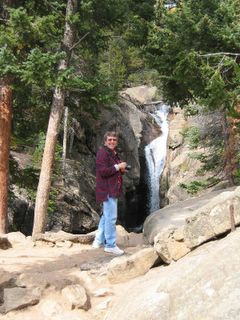
The road winds through some fabulous scenery, beautiful forests, occasional snow banks (from last winter), and finally meanders above timberline before reaching the top of the pass. At the visitor center and gift shop at the top, we always use our binoculars to observe one or more elk herds in the valley far below us. This trip, we also enjoyed watching a Golden Eagle soar below us, hunting squirrels and rodents in the valley and along the mountainside. It is always a rewarding viewpoint.
The aspen trees were changing colors while we were there, and we are always delighted by the brilliant yellow, gold, orange, light green, and even red leaves of the aspen. They stand out like flames or spotlights in the dark green of the pine and spruce forest. We never tire of observing and photographing these beautiful scenes. I took only a few digital photos this time, but Sue took up four rolls of 35mm film. She normally uses her good point-and-click camera, but has recently taken an interest in my old Minolta SLR, so she made good use of the zoom telephoto and wide-angle lenses on this trip. We are looking forward to seeing the results in a couple of days. Here are some digital photos I took:
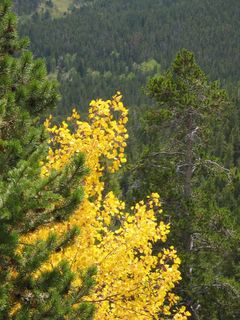

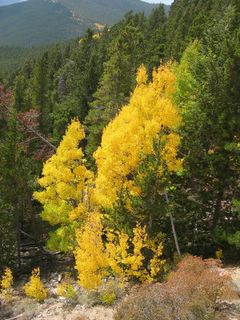

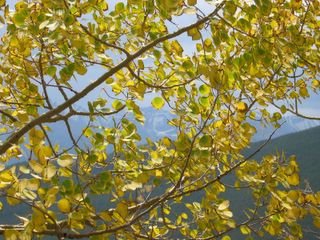
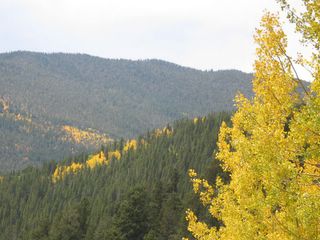
Several years ago, while just enjoying a scenic drive in the national forest north and east of Estes Park, we found a great picnic area called Fish Creek. It is in an excellent setting and is well-maintained by the Forest Service. We have had at least three picnics there, and I especially enjoy the drive through the forest on the Forest Service dirt road to get there from Masonville CO. In fact, the drive is mostly a circle, since we arrive at the picnic area from the south and leave to the north, then drive east along the Cache la Poudre River and return south to Masonville, and from there back to Estes Park. Here we are at Fish Creek:
The elk bugle sound is somewhat surprising, the first time you hear it. In the dark, it is a very eerie sound, especially when it echoes in the valleys, and you can’t be certain what direction it originally came from. When you can watch the bulls bugling, you expect to hear a deep, roaring sound from those massive beasts, but what you hear is a loud, high-pitched squeaking noise. Still, it is impressive.
We also search for sightings of Rocky Mountain Bighorn Sheep, but we have seldom seen them. On this trip, we did get to enjoy and photograph a dozen bighorn sheep grazing by the side of the highway through Big Thompson Canyon. That somewhat rare scene is a traffic-stopper, as all the tourists grab their cameras, and even some of the locals enjoy the sight.
Sue and I enjoy driving the old Fall River Road to the top of Milner Pass, in the park. This is a narrow, one-way dirt road that the National Park Service does not attempt to keep open in the winter. The paved two-way highway over the pass is kept open as long as possible, but is eventually closed by snow each winter. Along the Fall River Road drive, we stop at Chasm Falls, a most photogenic location, with just enough roadside parking to accommodate the folks who want to see it.

The road winds through some fabulous scenery, beautiful forests, occasional snow banks (from last winter), and finally meanders above timberline before reaching the top of the pass. At the visitor center and gift shop at the top, we always use our binoculars to observe one or more elk herds in the valley far below us. This trip, we also enjoyed watching a Golden Eagle soar below us, hunting squirrels and rodents in the valley and along the mountainside. It is always a rewarding viewpoint.
The aspen trees were changing colors while we were there, and we are always delighted by the brilliant yellow, gold, orange, light green, and even red leaves of the aspen. They stand out like flames or spotlights in the dark green of the pine and spruce forest. We never tire of observing and photographing these beautiful scenes. I took only a few digital photos this time, but Sue took up four rolls of 35mm film. She normally uses her good point-and-click camera, but has recently taken an interest in my old Minolta SLR, so she made good use of the zoom telephoto and wide-angle lenses on this trip. We are looking forward to seeing the results in a couple of days. Here are some digital photos I took:






Several years ago, while just enjoying a scenic drive in the national forest north and east of Estes Park, we found a great picnic area called Fish Creek. It is in an excellent setting and is well-maintained by the Forest Service. We have had at least three picnics there, and I especially enjoy the drive through the forest on the Forest Service dirt road to get there from Masonville CO. In fact, the drive is mostly a circle, since we arrive at the picnic area from the south and leave to the north, then drive east along the Cache la Poudre River and return south to Masonville, and from there back to Estes Park. Here we are at Fish Creek:
I really enjoy relaxing in the Adirondack chairs in front of our cabin, feeding peanuts to the squirrels, Stellar Jays, and sometimes a crow or a magpie. On previous trips, we’ve watched Clark’s Nutcrackers, but saw none of them this time. I feed the animals, read a book, and just relax in the great setting, sometimes even napping inside for a short while. These trips are definitely “retreats” for us.
Sue and I also enjoy doing some shopping in Estes Park, along with the many other tourists. We sometimes find great end-of-season sales on shirts, jackets, coats, gloves, and other clothing, and we always make a point of selecting some excellent fudge and other sweets from Laura’s Fine Candies store – “Spoiling Dinner Since 1970” is their slogan. Occasionally, I enjoy some saltwater taffy made at another store down the street. We usually have some Christmas gift ideas with us, and often find several gifts to put back for the holiday.
Sometimes, as was the case this time, I get some inspiration from the trip. On this trip, I had the urge to write down some passing thoughts one evening, and I’ve already posted them on my Word Sketches blog.
Obviously, it was another great trip for us, and we look forward to being there again next spring, and probably next fall, too.


